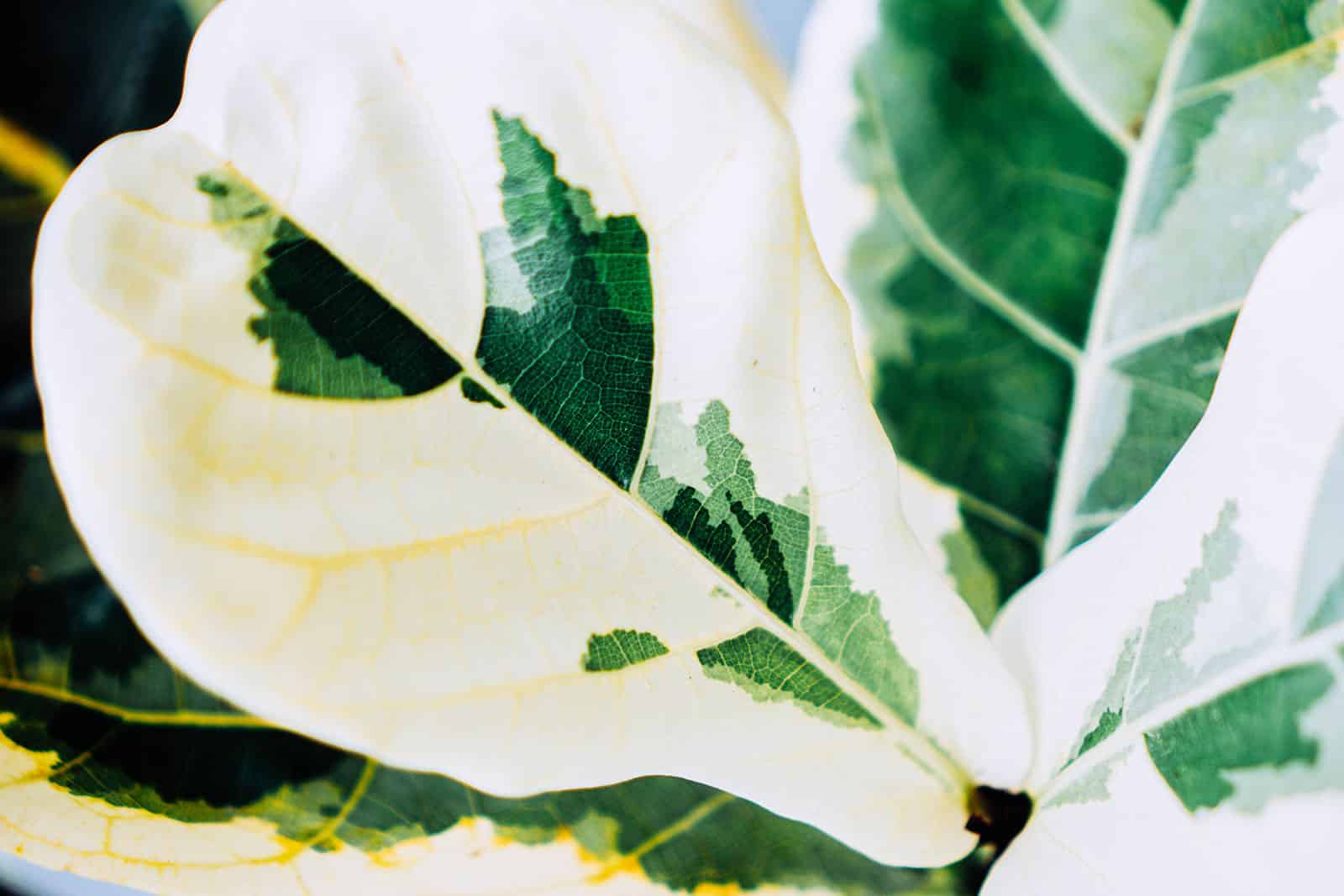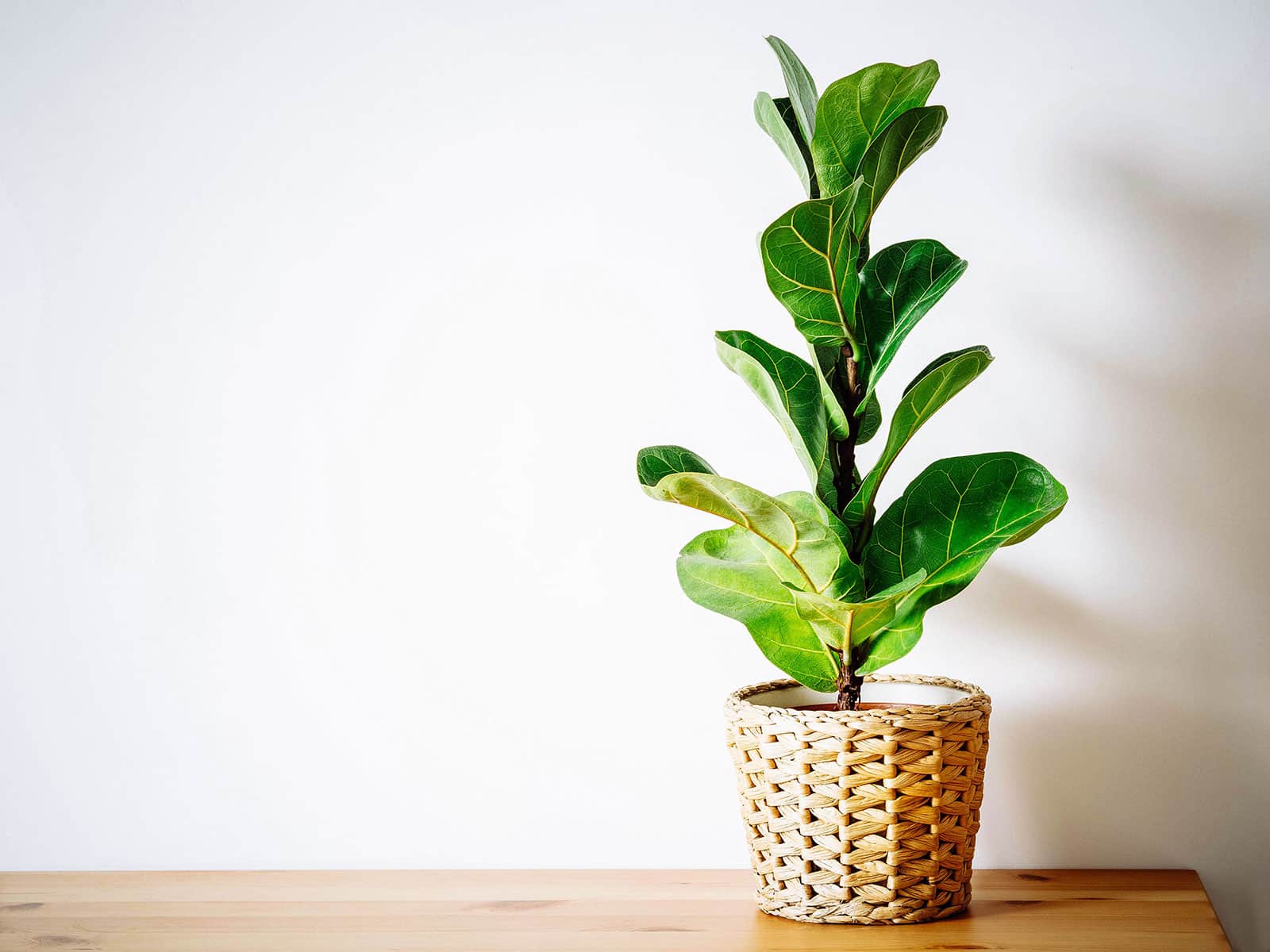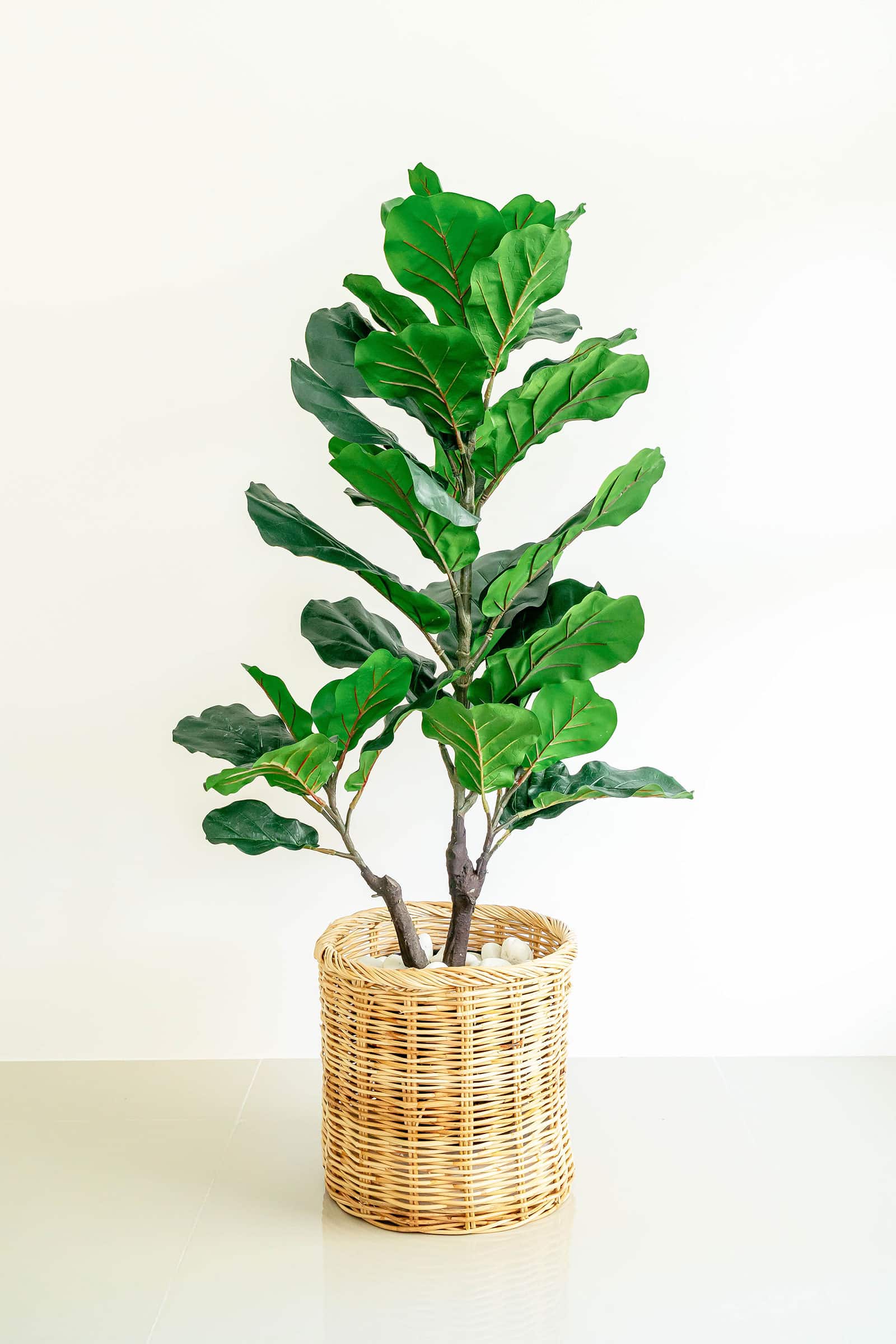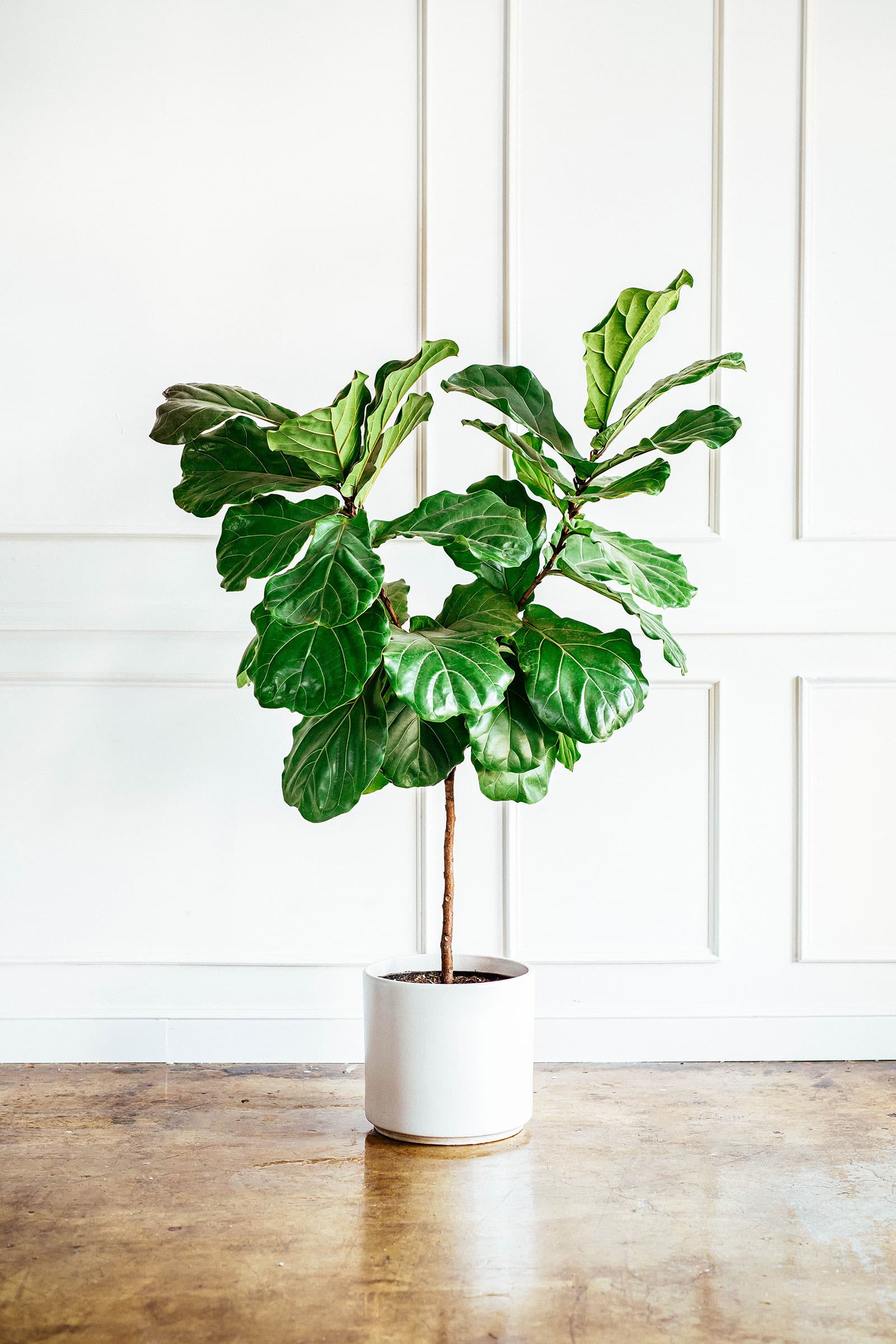Looking for a lush tropical houseplant to bring some soothing nature into your home? Ficus lyrata, also known as the fiddle leaf fig, may be the perfect choice for you. This indoor tree—with its easily recognizable, leathery lyrate leaves—can grow massive with the right care and give your home a great jungle vibe (without the mess of vines trailing everywhere).
Keep reading to find out everything you need to know about Ficus lyrata and how to care for this wildly popular houseplant.
| Common name(s) | Fiddle leaf fig |
| Scientific name | Ficus lyrata |
| Family | Moraceae |
| Height & spread | Up to 10 feet high and 3 feet wide (indoors) |
| Light | Full sun |
| Soil type | Rich but well-draining |
| Water | Let soil dry halfway |
Disclosure: If you shop from my article or make a purchase through one of my links, I may receive commissions on some of the products I recommend.

About Ficus lyrata
Description
It’s easy to see where the fiddle leaf fig got its name. The leaves on this tree species are indeed lyrate (meaning lyre-shaped, which also explains the scientific denomination). A fiddle’s foliage can grow very large, with leaves reaching up to 15 inches in length on adult plants. Combine that with the species’ elegant, thin trunk and it’s no wonder houseplant lovers worldwide have long swooned over this plant!
In the wild, fiddle leaf figs can reach a whopping 50 feet in height. Luckily, they stay much smaller indoors.
Natural habitat
The fiddle leaf fig is naturally found in western Africa, where it grows in tropical rainforests. It’s also an introduced species in a few other places, such as the Canary Islands.

Ficus lyrata varieties
Unlike some common houseplants, of which hundreds of different selectively bred varieties exist (Aglaonema or Philodendron, anyone?), there aren’t very many fiddle leaf fig cultivars to choose from.
As far as I’m aware, there are two:
- Ficus lyrata ‘Bambino’: A patented variety bred to be much more compact than a regular fiddle leaf. It also has smaller foliage.
- Ficus lyrata ‘Variegata’: Yep, although they’re difficult to find, variegated fiddle leaf figs exist. They’re very pretty, but expensive and more finicky.
I’ve also seen references to a Ficus lyrata ‘Compacta’, but I’m thinking this might just be another name for ‘Bambino’. There’s no patent to be found, and the reference to compactness make it sound like a ‘Bambino’ as well.
Where to buy
Fiddle leaf figs

Caring for Ficus lyrata
Light and temperature
The fiddle leaf fig may be incredibly popular, but it’s also notorious for being a species that many houseplant enthusiasts struggle with. A lot of this has to do with light: your Ficus really won’t tolerate being placed in a shady corner.
Many sources recommend indirect light for a fiddle leaf fig. But… I don’t agree.
Think about it: In their natural habitat, these guys would be blasted with sun! It’s better to place your fiddle in front of a sunny window, preferably a south-facing one (although you should acclimate it slowly if it was in a more shaded spot before).
A plant that’s receiving enough light will be much more forgiving in terms of watering and any beginner care mistakes. If you can’t offer a bright window, you can also consider a grow light.
As for temperatures, this is a tropical. In warm climates it’s commonly grown as an ornamental in parks and gardens, but unless it stays toasty year-round where you live, your fiddle leaf fig is better off as a houseplant—at least during winter. It prefers room temp or above.
If you’ve got outdoor space available, you can place your tree outdoors during summer. It’ll love soaking up the extra sun (though again, careful acclimation is key to prevent the leaves from burning). Take the plant back in once nighttime temperatures begin falling to 50°F or your Ficus might start dropping its leaves.
Did you know?
If you’re not an experienced houseplant grower (yet), the somewhat fussy fiddle leaf fig may not be the best choice for you. Why not try the sturdier Ficus ‘Alii’ instead?
Water and humidity
Attention, please! Watering is where things tend to go south with this slightly finicky Ficus. The majority of fiddle leaf figs is loved to death—they like a good sip of water, but if the soil stays wet for too long, root rot can set in.
Don’t blindly water on a weekly schedule. The amount of water your fiddle needs depends on factors like the season (light, temperature) and the soil type you’re using. It’s better to check the soil moisture level first and decide whether to give the plant a drink based on that.
Stick a finger into the soil. If it feels around halfway dry (and especially if the leaves seem a bit limp), you can go ahead and water. Still moist? Give it another day or two. If the soil feels wet, you should cut back on the watering to prevent trouble.
In practice, you’ll usually end up watering once or twice a week during the warm summer months (possibly more if your fiddle leaf fig is outdoors). In winter, when most of our houseplants are more or less dormant, a fiddle may only need watering every one-and-a-half to two weeks.
Quick Tip
If you’ve just brought your fiddle leaf fig home, it may drop some of its leaves. Ficus plants really don’t like to be moved. Don’t start watering a bunch in an attempt to compensate, as that’ll only make things worse!
Soil and planting
At least there’s one thing fiddle leaf figs aren’t too particular about: soil. The main thing is to use an airy soil mixture that allows excess water to drain quickly, as our houseplants, including this one, don’t like wet feet.
Mixing soil for your fiddle leaf fig can be as easy as combining normal houseplant potting soil with a handful or two (about 10 percent of the mix) of perlite.
If you’ve got some organic material on hand, be sure to add some of that as well. Compost or worm castings are great. You can also use peat or coco coir, especially if you tend to underwater (both of these materials are water-retaining).
The type of planter doesn’t matter much either, although it should definitely always have a drainage hole in the bottom to help prevent standing water. For large fiddle leaf figs, it’s best to use a sturdy and wide pot so your plant doesn’t topple over if you accidentally bump into it.
Depending on how well it’s growing, you can repot your Ficus every one to two years. You’ll know it’s time for a repot next spring if the soil is starting to dry out more and more quickly, or if the plant’s roots are starting to peep out of the drainage hole. Go up one pot size and don’t forget to give your fiddle some nice fresh soil.
Recommended products for fiddle leaf fig care:
- Good Earth Organics Premium Potting Soil
- Perfect Plants Organic Perlite
- Wiggle Worm Pure Organic Worm Castings
- Burpee Organic Coconut Coir
Fertilizing
Although fiddle leaf figs aren’t the quickest growers, they do appreciate some extra fertilizer during the spring and summer growing months. A regular balanced houseplant fertilizer should work fine, as would an all-purpose indoor plant food with an NPK (Nitrogen, Phosphorus, Potassium) ratio of 3-1-2.
Recommended fertilizers for fiddle leaf fig care:
- Elm Dirt Plant Juice Organic Fertilizer
- Houseplant Resource Center Liquid Fertilizer for Houseplants
- Bless Your Soil Fiddle Leaf Treats Indoor Plant Food
Pruning
There’s usually no need to prune a fiddle leaf fig. If yours has been through some trouble and one or more of the branches is bare, you can remove it, but it’s also fine to just leave it on. It may surprise you and resprout!
Any dead leaves can be removed when they’ve gone fully brown and crispy. If you want to tame an unruly plant, check out the section on propagation (below) to find out how to obtain more fiddle leaf figs while doing so.
Dividing or repotting
Fiddle leaf figs are not known for producing offshoots, so there’s not much you can do in the way of division. If yours has outgrown its planter, just go ahead and repot it.

Propagating Ficus lyrata
Because Ficus lyrata is a type of tree with a woody stem, it can be a little more challenging to propagate than other houseplants. But don’t worry—it can be done. By “beheading” your plant and placing the resulting cutting in water or fresh soil, you can cultivate a brand new one! You just need a healthy dose of patience.
Here’s how it works:
- Remove one of the branch ends of your plant, preferably at least around 5 inches. Ensure the cutting has an eye (growth nodule), as well as some leaves.
- In water: Remove the lower leaves from the cutting and place it in a glass of water. Set the glass and plant in a warm and light location (no direct sun).
- In soil: Dip the cut end in some rooting hormone (it really works!) and place it in a planter with fresh soil. Set the pot and plant in a warm and light location.
- Be patient!
If you’re propagating in water, you’ll see the first roots pop up within a few weeks to a few months (it can be a lot slower in winter). You can move your brand new fiddle leaf fig to soil once these roots have reached around 2 inches in length.
If the cutting is in soil, you can start giving it a weekly light tug after around a month. If you feel any resistance, that means it’s rooting! Once the first new leaves appear, you can call your propagation attempt a success.
For those interested, you can also propagate a fiddle leaf fig using the air layering method. This takes longer, but it does improve the chances of the cutting taking. The concept is to create a wound on the stem and then covering it in moist sphagnum moss. Your tree will think it should start producing roots in the damaged spot.
When the roots have reached a good length, you cut the stem right below them. Voilà, a pre-rooted cutting! All you have to do is plant it.
Did you know?
If you place a fiddle leaf fig leaf in water, it will often eventually grow roots. The leaf will stay intact indefinitely, although it will never produce a new plant. Still, it looks nice in a vase, and it sure lasts longer than cut flowers do!

Is a fiddle leaf fig toxic to cats and dogs?
Although taking a bite out of your fiddle leaf fig won’t be the end of your furry friend, this Ficus is indeed considered toxic. The latex-like sap can irritate the skin and mucus membranes due to a compound it contains called ficin. This substance causes swelling and rashes, and can also provoke vomiting or diarrhea.
If you think your pet has taken a bite of your fiddle leaf, offer plenty of water and observe the animal closely for the next 24 hours. If you’re unsure, contact your veterinarian for advice on whether you should come in or not.
Source:
- https://powo.science.kew.org/taxon/urn:lsid:ipni.org:names:853158-1/general-information















